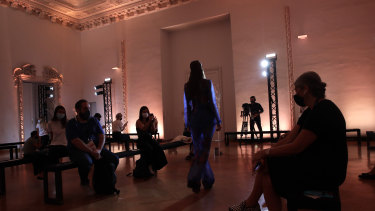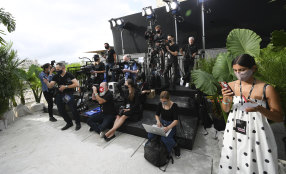Can luxury fashion ever regain its lustre?
This is usually a busy month for the luxury industry. Not long after glossy fashion magazines publish their all-important September issues, thousands of retail buyers, journalists and clients embark on a tour of New York, London, Milan and Paris.
Rolling from city to city to attend fashion weeks, they decide the trends that will power a global luxury goods market worth hundreds of billions — in 2019, €281 billion euros, or $459 billion.
Not this year. The ground beneath the industry is heaving under the weight of a pandemic that has caused a plunge in sales, shocked global supply chains and pushed American household names such as Brooks Brothers and Lord & Taylor to bankruptcy.

Those shifts have prompted big questions about the business model of luxury fashion. Should fashion weeks be dismantled and rebuilt? Are cycles of new items every six months still the best approach, at a time when garment overproduction is under scrutiny, restricted lifestyles are commonplace and runway spectacles can feel out of step in a world with different priorities?
The second quarter of 2020 was the luxury fashion industry’s worst. According to estimates by Boston Consulting Group, global luxury sales are set to contract by 25 per cent to 45 per cent this year, with industry growth unlikely to return to pre-pandemic levels until at least 2023 or 2024. At a time when many companies are battling for survival, many designers feel they cannot afford to skip an opportunity to show new wares.
So as the latest fashion week season began in New York last week, blockbuster catwalk shows and big crowds were out, replaced with a handful of small-scale or online-only presentations. In Italy and France, some brands have said they plan to host larger physical events, despite having only a handful of international guests, a number of high-profile designer absences and rising infection rates in Europe.
The luxury sector currently has more than double the amount of stock on its hands than it usually would at this time of year.
Boston Consulting’s Stefano Todescan
“Showing is not essential. However, sometimes you do need to show what you’re actually creating,” Antoine Arnault, head of communications at LVMH Moët Hennessy Louis Vuitton, told The New York Times on September 9.
“There’s a whole economy around these shows. That should not be underestimated,” he added, alluding to the thousands of freelance makeup artists, seamstresses, drivers, security guards and photographers who rely on fashion weeks for a sizeable part of their incomes.

Large groups like LVMH, which owns brands including Dior, Louis Vuitton and Fendi, and its rival conglomerate Kering, which operates the likes of Gucci, Saint Laurent and Balenciaga, have been more insulated from the bitter pandemic headwinds than most smaller stand-alone businesses. (LVMH, though, has entered a court battle in an effort to extricate itself from a $US16 billion commitment to buy the jeweller Tiffany & Co)
In its latest quarterly earnings report, LVMH said it had seen a strong uptick in sales in the summer from Asian countries like mainland China, Japan and South Korea, where recent virus rates have stayed low. But sales for its fashion and leather goods unit fell by 37 per cent, as international tourism ground to a halt and footfall into global stores was slow to recover.
Glut of unsold inventory
The impact has been even worse for brands in turnaround efforts like Salvatore Ferragamo and Burberry, debt-ridden department stores like Neiman Marcus, and the cash-poor independent brands with large exposure to those types of retailers (many of whom scrambled to cancel and return orders). Most companies are now struggling with a large glut of unsold inventory from the spring and summer collections this year.
“The luxury sector currently has more than double the amount of stock on its hands than it usually would at this time of year, much of which is now unlikely to be sold at full price,” said Stefano Todescan, managing director of Boston Consulting Group. Many brands have been using brick-and-mortar discount outlets or online marketplaces like the Dutch startup Otrium to try to shift the designer clothes piling up in warehouses.
Todescan said the brands that fared better this year were generally those that relied on data to gain a granular understanding of where their stock was. This allowed them to move supply from the West to better performing regions like the Asian markets, where huge crowds unleashing pent-up demand for luxury goods inspired the phrase “revenge shopping.”
“The pandemic has further polarised luxury’s winners and losers and accelerated trends that were already underway before the crisis began,” Todescan added. “Brands like Hermes and Chanel, who never discount, are less trend-led and with product ranges that sell through multiple seasons, have emerged in particularly good shape.”
China, online become vital
China, which was already the fastest-growing luxury market before the pandemic, will become even more vital to brands’ success as North American and European markets remain unpredictable. And everywhere, offline retail has had to go online — and fast — as consumers turned rapidly to digital shopping.
Amazon, whose customers have ordered over 1 billion fashion items via its mobile app in the last 12 months, has long looked for a way to become partners with luxury names, which had in the past largely rebuffed its advances. Last week, Amazon launched its mobile-only Luxury Stores with one brand: Oscar de la Renta. It said that more labels would be announced in the weeks to come.
Farfetch, the digital marketplace that allows upmarket vendors to sell their goods online, reported last month that it had seen a 60 per cent surge in traffic for the second quarter compared with the same period last year — and 500,000 new customers.
“E-commerce represented just 12 per cent of luxury sales in 2019. Since then there has obviously been a complete paradigm shift,” José Neves, Farfetch’s chief executive, said. Luxury used to be heavily associated with an in-store experience, he added.
But for many consumers in 2020, convenience and safety are now front of mind, prompting many brands to fast-track their digital strategies. “For those who aren’t able to do that, it is going to be a struggle,” Neves said.
As the industry starts to offer up new looks, TikTok is hosting its own online fashion month for a potential audience of roughly 800 million users, with shows by Saint Laurent and JW Anderson.
Expect to see smaller collections with more timeless pieces that can have extended shelf lives if necessary. Demand for evening wear and suits has plummeted now that no one has a reason to dress up, though many brands say they expect people to start buying high-priced items that aren’t tracksuit pants, despite a severe recession and ongoing layoffs.
With no fixed timeline for a COVID-19 vaccine, it will be hard to predict what customers will want six months from now. But for luxury fashion, the shows must go on.
The New York Times
Most Viewed in Business
Source: Thanks smh.com